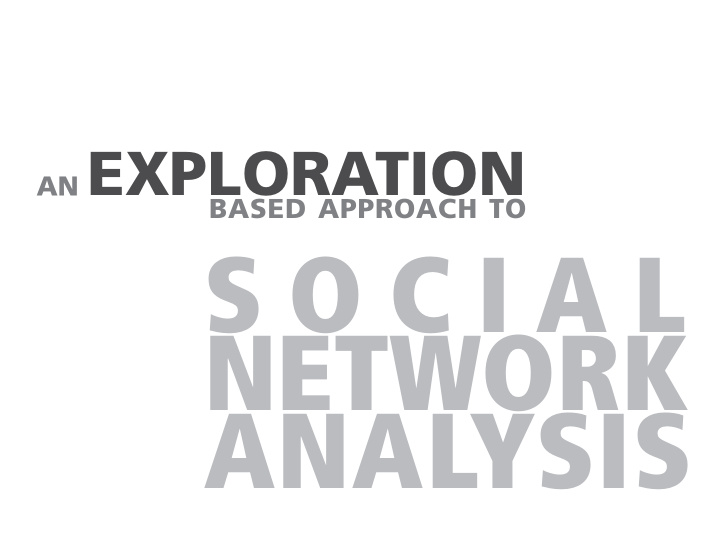



AN EXPLORATION BASED APPROACH TO S O C I A L NETWORK ANALYSIS
CURRENT VISUALIZATION PROBLEMS Flat network structure and a Poor organization leads Network presentation can lead lack of focus lead to a shallow to overwhelming network to overconfj dence. understanding. structure. These problems compound upon each other, making it diffj cult to synthesize a working knowledge, let alone infm uence the analysis process towards insight.
AN EXPLORATION CONCEPT Building an understanding of the social network through the PROCESS of CREATION , rather than attempting to understand the implications and meaning of the social network as the OUTPUT of a program. (Our approach is a result of our background...)
? WHAT DO WE KNOW ABOUT EXPLORATION
WHAT WE KNOW ABOUT EXPLORATION * Intrinsically human... * Concepts and strategies (affordances) that humans use to explore physical spaces were used as an analogy for how we can explore a social network environment.
DRIVING CONCEPTS AND STRATEGIES 1 SELECTING A FOCUS *Links make the social network: the information contained in links is as rich, if not richer, than node information. We must move beyond a static structural view and treat the links dynamically. *Both links and nodes: while links are important, only by being able to shift focus between links and nodes can we really begin to see the dynamics of a complex social network.
DRIVING CONCEPTS AND STRATEGIES 2 MULTIPLE NETWORK SCALES *Multiple scales across multiple dimensions: in order to provide a relevant and focused picture of a social network, it is necessary to organize the network into multiple scales across both groupings and links. *Perspective Shifting: Because each perspective simultaneously reveals and obscures, it is crucial that we be able to shift across multiple perspectives rather than viewing the data from a single perspective, or alternatively, from a single amalgamated perspective. Analysts must be able to synthesize a relevant understanding that is grounded in multiple perspectives because ... No agent within a network has a complete understanding of the entire system.
DRIVING CONCEPTS AND STRATEGIES 3 EXPLORATORY ORGANIZATION OF SPACE based upon attributes of both nodes and links. *Social network organization: a network organized across some dimensions can appear arbitrary when viewed in light of other variables. *Axes: humans are good at grouping things, and we need to facilitate that, but we also need to ensure that we are recording a grouping relative to a given variable, so that when viewed in light of other variables the network structure will retain it’s original meaning.
DRIVING CONCEPTS AND STRATEGIES 4 REPRESENTING PATHWAYS *Tracking non-standard information: it is often relevant to track non-standard information and objects, both physically and temporally, as they move through the social network.
DRIVING CONCEPTS AND STRATEGIES 5 EXPLORING TEMPORAL EVOLUTION *Temporal history VS temporal evolution: many current programs include some temporal aspect, however it appears to be little more than a dynamic document history. *A combination: looking at the temporal evolution in conjunction with the rest of our concepts illuminates the actual evolution of the network, and helps to turn the model predictive.
CAVEATS, WARNINGS + GENERAL DISCLAIMERS * INSTANTIATING CONCEPTS... In order to illustrate how these concepts have relevance to social network representations an animated mock up was created to serve as a compelling design seed. Each function demonstrated helps us to shift through various perspectives of the social network and each perspective instantiates the concepts we have outlined. It is important to remember that this is not a tool [it is not how a real tool would function] and is simply one of many possible instantiations of the concepts.
Recommend
More recommend